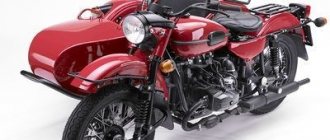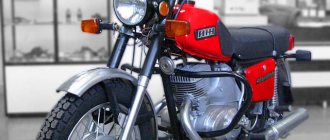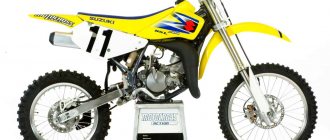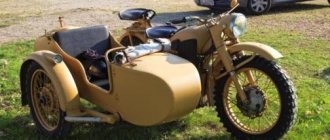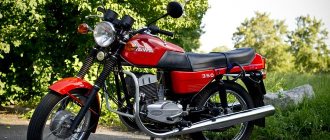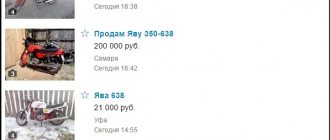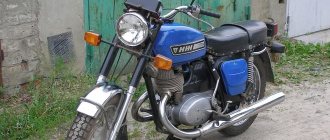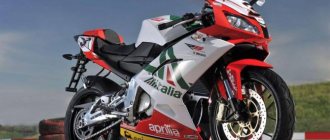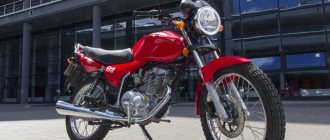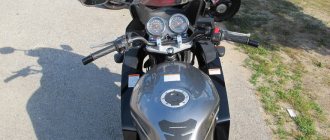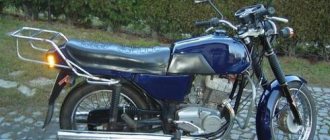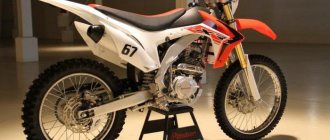The first attempts to create a two-wheeled motor unit have been known since 1885. The copies were equipped with a kerosene engine, a wooden frame and a sidecar. The speed limit for such equipment reached twelve kilometers per hour. In the USSR, the K-750 motorcycle was designed in the early thirties of the twentieth century. It was a copy of its German counterparts. Nevertheless, there was something unique and fascinating about him.
How to increase the compression ratio on the K750
Not for boosting, but for the purpose of optimization for modern gasoline, because...
Even the 80th is no longer found everywhere, is it possible to do something and how? yep, thanks. we honor.
By the way, you can keep the cardan for yourself. I don't have that much time to live on the forum and know every topic.
Nonsense there. You just remove 1 mm from the cylinders from the head side and don’t worry.
Well, let's see what happens with the other gasoline. Now we’ll just plug in the 68th carbs and check them.
Jay about nonsense, you’re wrong. The first stage of fine-tuning the engine (precisely fine-tuning, since I didn’t want to turn the engine but to increase the torque) is precisely the conversion of the cop. It’s not that it’s undesirable to trim the cylinder from the KS side. nonsense! My timing system is standard, it’s not my thing to turn the engine.
In general, I think it’s obligatory to remake the KS in an SV engine according to the Pindos principle, they took half as much power from the engine in the standard 45 (there is something to think about). By filling the well, you will increase the compressor, place a spark plug above the intake, you will achieve optimal purging and better ignition of the mixture . In the standard, the spark plug is in a completely unnecessary place, it seems that they did it for the sake of convenience and aesthetics (for some reason this did not surprise me). In general, the essence of the modification is not so much in switching to a new gasoline or boosting, tuning the engine, but in increasing its efficiency, which goes without saying already makes sense.
The location of the spark plug is the same as in HD ha Technical description: engine: 2 cylinders, 4 strokes volume: 738 cm3. power: 23 hp at 4600 rpm compression: 5.7 : 1 Piston stroke: 79 mm piston diameter: 79 mm
Properties: -Speed 120.0 km/h -Trunk capacity 150 -Capacity 2 people -Gasoline tank 23.0 l -Fuel consumption 8.0 Technical characteristics of the BMW-R71 motorcycle 1938 - 1941
Length, mm: 2130; Width, mm: 815; Wheelbase, mm: 1400; Height, mm:960; Ground clearance, mm: 135; Dry weight, kg: 187; Gas tank capacity, l: 14; Fuel consumption, l/100 km: 4.5; Oil consumption, l/100 km:1; Maximum speed, km/h: singles 125, with sidecar 105
I think the difference in speed may be due to the fact that measurements in the USSR were carried out with a full passport load. But I'm not sure about the Germans.
Engine Type: Air-cooled bolt-on, 45-speed V-pair, two valves per cylinder Displacement: 750cc Bore x Stroke: 70 x 97mm Compression Ratio: 7:1 Power Required: 46 horsepower Top Speed: 140 mph Carburetion : Linkert MR4 Transmission: Four-speed Ignition: Magneto Structure: Special KRTT, double loop cradle Front suspension: Telescopic, no adjustment Rear suspension: Twin shock absorbers, no adjustment Front brake: Drum, special KRTT Rear brake: Drum, special KRTT Front tire: 3.25 x 19" Rear Tire: 4.00 x 19" Wheelbase: 1,321mm (52") Seat Height: 738mm (29.5") Fuel Capacity: 19ltr (5gal)
With XERa, do they have 46(. ) baldness at 750cc and 70x97(. ) mm and at st compressor 7.0:1?
IMHO, NAGORA DIFFERENT MEASUREMENT METHODS
Source
Other parameters
The ignition of the K-750 motorcycle is combined with a six-volt battery. The battery is of type ZMT-12, the generator is G-414 with a regulatory relay RR-302. In addition, the electrical equipment includes an induction coil and an interrupting distributor.
Chassis characteristics:
- closed double tubular frame;
- front telescopic suspension;
- rear suspension unit - lever-pendulum type with spring shock absorbers;
- front / rear wheel travel (amplitude) – 14 / 9.5 centimeters;
- tires – 3.75 / 19 inches.
The brake system is a drum assembly with friction shoe linings.
Ural motorcycle engine tuning: detailed information
Tips on how to tune a Ural motorcycle engine, what little details you should pay attention to and what is used in the work
What owner of a domestic motorcycle has not thought about tuning the engine of a Ural motorcycle? This burning question worries many fans of domestic Ural motorcycles! The fact is that the standard Ural engine has many manufacturing inaccuracies and is technically imperfect. Depending on the model and year of manufacture, the power of the Ural motorcycle varies from 32 to 36 horsepower, which in our time is considered low for an engine capacity of 650 cubic centimeters. In this article we will look at how to increase the power of a stock outdated engine. I would like to note right away that a lot of turning work will be required; find a workshop in advance that will agree to help you in this matter.
The Ural boxer engine has great potential for tuning, thanks to a piston diameter of 78mm and a stroke of 68mm. With this configuration, the engine could be revving, unfortunately the quality of the parts and the purpose of the motorcycle do not allow this to happen. In the article we will look at the solution to this problem, due to which you can achieve impressive results from the operation of such an engine, namely:
How did it all begin?
The K-750 motorcycle can be called one of the very first Soviet two-wheeled vehicles, which gave impetus to the further development of this direction. Its mass was almost 320 kilograms, and the car was accelerated by a power unit with a capacity of twenty-five horsepower and a volume of 745 cubic centimeters. Driving characteristics were provided by a four-speed gearbox, coupled to the drive wheel via a driveshaft.
The brake system was equipped with a pair of reliable drum mechanisms with flexible cables. The fuel tank with a capacity of twenty liters allowed it to cover a distance of up to 350 kilometers without refueling. Average fuel consumption was about six liters per hundred kilometers. The K-750 motorcycle was initially well-thought-out in design, and it is still reliable in operation today.
Engine head tuning
Through the channels of the engine heads, the cylinders are filled with a fuel mixture, and exhaust gases are released. The more efficiently the cylinders are filled and the exhaust gases escape more easily, the greater the engine power. To tune the Ural engine heads, you will need to remove the valves. The diameter of the original Ural valves is only 38mm inlet and 35mm exhaust, which affects the suffocation of the engine. Along with the valves, you need to press out the old valve seats and guides. The seats for the saddles should be bored to the size of the Dnieper saddles. New enlarged seats will allow the installation of larger diameter valves 40mm inlet and 38mm exhaust from the Dnieper. The best alternative to Dnepr valves would be valves from Audi. The quality of automobile spare parts is much higher, and thanks to the fixation with new type of crackers, the service life of the heads can be significantly increased. We recommend using bronze valve guides from VAZ 2101-2107.
Internal grooves improve lubrication of the valve stem. The movement of valves in them is the most efficient with minimal friction losses, and the service life is much longer. Bronze perfectly removes heat from the valve, which will have a positive effect on the stability of valve clearances.
It is important to know: when choosing valves, do not run into a fake. Exhaust valves made of heat-resistant steel should not be magnetized. Bronze guides are also not magnetic.
Improvement
Over time, the K-750 motorcycle was restyled and received the prefix “M” in its name. The front fork has been replaced with a telescopic counterpart. The gearbox has also been updated and received a foot drive. The updated driveshaft is now adjustable in length. The power unit has undergone significant changes.
The valves in the new engine are located on top, which, with the old cylinder volume, allows the power to be increased to 32 “horses”. Engine speed remained at 5200 rpm. The prefabricated crankshaft was converted into a one-piece design, the connecting rod bearings were removed, and Babbitt bearings were installed instead. Thanks to the modernization, the service life of the unit increased to 40 thousand kilometers, and repairs became easier. The cylinder heads have also been restyled. As a result, the K-750M motorcycle became faster and more maneuverable. It could accelerate to 105 km/h while consuming less fuel (5.98 liters per 100 km). The installation of an automatic ignition timing system also affected the efficiency of fuel consumption.
Cylinders and pistons
One of the most important parts in an engine is the pistons. They take on a huge load from expanding gases and temperature. Low-quality standard pistons do not withstand loads well, often have different weights, and the piston rings cannot provide high compression due to their outdated design, this significantly affects the power, and the massiveness and number of rings make the piston very heavy, which prevents the engine from spinning. It is recommended to install forged pistons with imported rings. A good solution would be to install forged pistons from the Ural Wolf motorcycle; they have a convex surface, which will increase the compression ratio and significantly increase engine power.
As for the cylinders, it is preferable to replace them with aluminum ones with a cast iron liner. The thermal conductivity of aluminum is much higher, and effective heat dissipation is ensured. A significant improvement in cylinders is relining. The standard internal diameter of the cylinder liner is 78 mm, and if the volume of the standard engine of 650 cubic meters does not suit you, by replacing the original cylinder liners with liners from Moskvich 412 with an internal diameter of 82 mm, you can significantly increase the volume and, accordingly, power. Select the pistons accordingly for the new diameter.
To combat overheating, a cooling system in the form of installing an oil cooler and by forcefully spraying oil onto the bottoms of the pistons will be useful. To connect the oil cooler, an additional oil pump is needed, since the standard one is very weak. To pump oil through the radiator, it is advisable to install an oil pump from a Dnepr motorcycle. Drive the second pump through an adapter from the standard Ural pump. In order for the additional pump to fit in the crankcase, an enlarged sump is required, which will also have a positive effect on cooling. By slightly increasing the amount of oil in the system, it will be possible to distribute the thermal load, and the new aluminum pan will remove heat even better.
By connecting to the new oil pump an oil line made of a copper or steel capillary tube, which must first pass into the radiator, then cooled oil from it must flow to the inside of the pistons. To do this, the line from the radiator enters back into the crankcase and bifurcates so that the oil supply is directed to the bottom of the piston from the inside. An oil cooler can be purchased at a Japanese motorcycle dismantling shop, and an automatic transmission radiator of the size you need from any car is also perfect.
Carburetors and ignition
Tuning a Ural motorcycle engine affects all engine systems, including ignition and carburetors. It is recommended to read the information: how to properly configure Ural carburetors. The standard ignition is so outdated that it is not even suitable for everyday driving, let alone anything else. It is desirable to install a microprocessor ignition with the possibility of an automatic advance angle. This article will help you set up the electronic ignition system. Ideally, such an ignition would be installed with a programmable controller with the ability to adjust the firmware. Such ignition systems have another useful feature - speed cut-off. This will prevent over-torque of a heavily boosted engine. Well, for maximum spark strength, in combination with a new ignition, you can use a coil from the Oka or Gazelle. Branded high-voltage wires with silicone insulation and internal resistance are required, for example from Tesla from VAZ 2108. They will ensure an uninterrupted spark in any weather and eliminate the possibility of spark breakdown to ground. As for carburetors, you will need to install Japanese vacuum carburetors with a diffuser diameter of 32 to 36 mm, followed by selection of jets, synchronization and adjustment with a gas analyzer. Tuning on a dynamometer is highly advisable, where you can test different settings and ignition timing and get the most out of your motorcycle tuning!
What do the owners say?
The lucky ones who have this rarity in their fleet note that after additional tuning the unit looks quite solid. Comparing it with the most modern models, users focus on the unique engine performance, evoking a certain nostalgia for Soviet transport. After all, the clutch of the K-750 motorcycle, like the engine and other components, could be sorted out and repaired yourself, rejoicing at the success achieved in the end.
If we move away from the lyrics, we note that finding spare parts for the unit is quite problematic, not to mention a full-fledged car on the move. This is not surprising, because its production stopped a long time ago. However, persistent collectors still find what they are looking for, despite the difficulties.
Additional engine modifications
In addition to the above methods of tuning a Ural motorcycle, there are several more secrets. It is possible to install a crankshaft from the K 750 on the Ural engine, which will increase the cylinder stroke to 78mm.
Thus, it is possible to significantly increase the working volume of the Ural engine. It's quite difficult to find, but it's worth it. Another problem with the motorcycle is the tight response to the throttle and slow acceleration. The reason for this is that the flywheel is too heavy, the weight of which is designed for riding with a stroller and for transporting heavy objects.
According to the drawing, it is possible to reduce its weight by a couple of kilograms. Due to the weight reduction, the inertia of the crankshaft will decrease, and the acceleration dynamics will significantly increase. To fully realize the power on the road, the gears of the gearbox must be replaced with 9 or 10 pairs. In conclusion, we would like to note that tuning the Ural motorcycle engine is justified only for racing purposes; for everyday use, such an engine will have a short resource and significant fuel consumption.
Source
Usage
K-750 motorcycles were widely used by law enforcement agencies. In the 50-60s of the last century, motorcycles with sidecars were the main patrol vehicles of the police. The K-750 rarely came into private hands until the mass decommissioning of vehicles from the army and police units occurred in the early seventies. Almost all of the decommissioned motorcycles went on retail sale and were snapped up by the public.
Messages [from 41 to 60 of 76]
41↑ Reply from 666 20-10-2011 14:38:09
Re: K750 engine tuning
Then you can make the connecting rods to order... a little longer... although this is wrong of course... after all, the amplitude is sq. Will not change.
42↑ Reply from Grican13 20-10-2011 14:53:39
Re: K750 engine tuning
It's too much. You don’t need to do anything with the Kasovsky kv!
43↑ Reply from t 34 20-10-2011 15:56:39
Re: K750 engine tuning
44↑ Reply from Aibolit 10/20/2011 22:51:14
Re: K750 engine tuning
Ek, comrades, where have you gotten yourself :-)) And we started with the fact that Kasyan’s KV is a little salty. I still think that this is the key problem. The idea with spacers for the cylinders is productive. If only the HFs were compatible.
45↑ Reply from Grican13 20-10-2011 23:32:08
Re: K750 engine tuning
46↑ Reply from Aibolit 10/21/2011 09:10:06
Re: K750 engine tuning
You are absolutely right. Apparently, we will give up our ambitions for now, the costs are high, and the results are problematic. Having done the math, I’m inclined to think about using an engine from the Wolf, at least we’ll get some experience installing supercharging on a boxer, and we’ll see what problems pop up during operation.
Messages [21 to 40 of 76]
21↑ Reply from Grican13 10/19/2011 00:13:20
Re: K750 engine tuning
But he is the best option. Unless the guys have access to CNC to order and make their own CV for plain bearings.
22↑ Reply from Aibolit 10/19/2011 10:19:43
Re: K750 engine tuning
Thank you! Especially for the comparison photo. Sadly. If the central cheek of the CV is the same for all exhibits, then the mutual displacement of the axes of the cylinders in Kasyan is 2 mm less than in the other Urals :-(. Exclusive, blah.
23↑ Reply from Grican13 10/19/2011 11:00:43
Re: K750 engine tuning
Well, if it’s only 2 mm, then you can put it from a wolf. I don't think the connecting rod is bent. Offset too small. 1mm per cylinder, I don’t think it’s scary.
24↑ Reply from 666 10/19/2011 11:31:36
Re: K750 engine tuning
this millimeter can be caught through the piston bosses... well, where the finger enters... grind off 1 mm on one side. and on the other place a brass washer of the same thickness of 1 mm...on the 2nd cylinder similarly...
25↑ Reply from Aibolit 10/19/2011 12:14:29
Re: K750 engine tuning
this millimeter can be caught through the piston bosses... well, where the finger enters... grind off 1 mm on one side. and on the other place a brass washer of the same thickness of 1 mm...on the 2nd cylinder similarly...
26↑ Reply from Grican13 10/19/2011 12:35:31
Re: K750 engine tuning
Well, if you think logically, then yes. The force of the burning gases will try to bend the square. Not okay. This means you have a direct path to CNC.
27↑ Reply from 666 10/19/2011 13:16:24
Re: K750 engine tuning
28↑ Reply from t 34 10/19/2011 16:20:23
Re: K750 engine tuning
29↑ Reply from Grican13 10/19/2011 16:30:41
Re: K750 engine tuning
Added: 19-10-2011 15:30:41
By the way. A classmate told me today that he has a book on preparing a car for sports. Exactly 50s 60s. Low valve engines were inflated there. By the way, they were inflated with volumetric ones.
